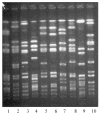Origins of community strains of methicillin-resistant Staphylococcus aureus
- PMID: 15206052
- PMCID: PMC2567833
- DOI: 10.1086/421090
Origins of community strains of methicillin-resistant Staphylococcus aureus
Erratum in
- Clin Infect Dis. 2004 Jul 15;39(2):291. Edlin, B [corrected to Edlin, BR]
Abstract
To characterize methicillin-resistant Staphylococcus aureus (MRSA) strains circulating in the community, we identified predictors of isolating community MRSA and genotyped a sample of MRSA collected from a community-based, high-risk population. Computerized databases of the Community Health Network of San Francisco and the Clinical Microbiology Laboratory were searched electronically for the years 1992-1999 to identify community-onset infections caused by MRSA. Sequential analyses were performed to identify predictors of MRSA strains. The majority (58%) of infections were caused by strains traceable to the hospital or to long-term care facilities. Injection drug use was associated with infections that were not associated with health care settings. Genotypes for 20 of 35 MRSA isolates recovered from injection drug users did not match any of >600 genotypes of clinical isolates. In a nonoutbreak setting, the hospital was the main source of community MRSA; however, the presence of genetically distinct and diverse MRSA strains indicates MRSA strains now also originate from the community.
Figures


References
-
- Salgado CD, Farr BM, Calfee DP. Community-acquired methicillin-resistant Staphylococcus aureus: a meta-analysis of prevalence and risk factors. Clin Infect Dis. 2003;36:131–9. - PubMed
-
- Dufour P, Gillet Y, Bes M, et al. Community-acquired methicillin-resistant Staphylococcus aureus infections in France: emergence of a single clone that produces Panton-Valentine leukocidin. Clin Infect Dis. 2002;35:819–24. - PubMed
-
- Charlebois ED, Bangsberg DR, Moss NJ, et al. Population-based community prevalence of methicillin-resistant Staphylococcus aureus in the urban poor of San Francisco. Clin Infect Dis. 2002;34:425–33. - PubMed
-
- Hussain FM, Boyle-Vavra S, Daum RS. Community-acquired methicillin-resistant Staphylococcus aureus colonization in healthy children attending an outpatient pediatric clinic. Pediatr Infect Dis J. 2001;20:763–7. - PubMed
Publication types
MeSH terms
Substances
Grants and funding
LinkOut - more resources
Full Text Sources
Medical

